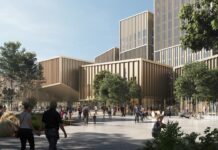
An Ontario Association of Architects (OAA) task group says the new Toronto City-Wide Zoning By-law (CWZBL) virtually eliminates sustainable design elements such as green roofs and solar panels, discriminates against flat roof housing, and will require standard Toronto neighbourhood architecture to go before a city committee to approve what will now be “a minor variance.”
The OAA task group believes the public and city councillors need to be made aware of the impacts of the CWZBL. The committee is meeting March 6 to put forward its recommendation to City Council to approve the CWZBL. The OAA task group was one of many stakeholders consulted during the process, but their concerns were dismissed, the OAA says in a news release.
“Overall the city is taking a counter-productive and regressive approach to city planning at a critical time when urban environments are rapidly changing and the world is looking for sustainable solutions for modern living and communities,” says architect Robert Abrahams, chair of the OAA task group. “We believe this version of the CWZBL will set Toronto back, not move it forward.”
This version of the CWZBL is the second attempt at introducing this bylaw; the first time being repealed as it overwhelmed Committee of Adjustment panels with minor variance applications; stifled residential construction, and pitted neighbours against neighbours over variances that were forced to go before the provincial body, the Ontario Municipal Board. The OAA task group argues that the CWZBL will do exactly the same this time around.
The OAA task group is not in opposition to a CWZBL for the City of Toronto and supports the city’s intent. However, it strongly opposes a version of the CWZBL that does not reflect the overarching Toronto’s Official Plan directive for a physically “diverse and inspiring city (with) beautiful architecture and excellent urban design that astonish and inspire.”
Under the proposed CWZBL, the future of contemporary architecture in Toronto looks disastrous, the task group says in its news release. Instead of spelling out basic restrictions under which an architect can work, it imposes strict design restrictions that effectively promote one single style of house.
“The residential works of Toronto’s most celebrated architects, both past and present, would have fallen prey to the CWZBL,” says architect Sheena Sharp, a task group member. “The current residential works of Toronto’s best and brightest architects whose services are in high demand, will be handcuffed by a zoning by-law that prevents creativity and good design. Even residents who want an addition to support a growing family will face the same challenges and increased costs.”
While some design features may be allowed a variance at the Committee of Adjustment, the OAA task group cautions this is a time-consuming and costly process. And these variances, including design features that are frequently used already, could now be refused for being in opposition to the CWZBL.
“Our main concern is that the Official Plan guides the direction of architecture and urban design in the city. This by-law goes against that. How can the City of Toronto simultaneously give Urban Design and Green Design awards to residential projects while adopting a zoning by-law that effectively prohibits them?”
As the city evolves and architecture and urban design continue to become collaborative processes, Toronto needs a by-law that is efficient and effective for everyone involved, the task group’s news release says.






